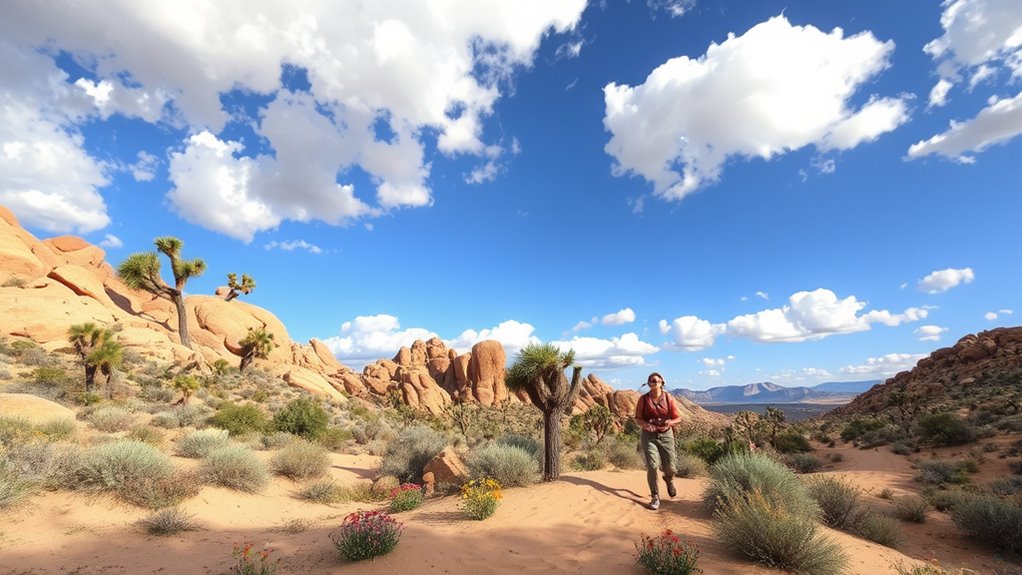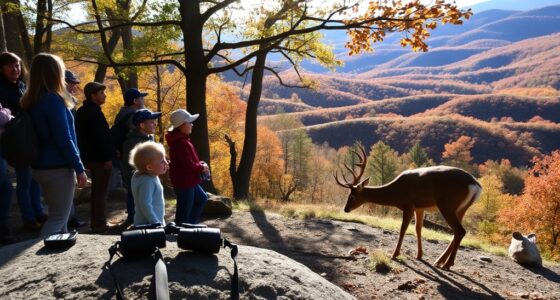When hiking in Joshua Tree National Park, stick to established trails to protect delicate plants and ecosystems. Avoid climbing on fragile rock faces and follow designated routes to lessen your impact on the environment. Always carry out trash and personal items, leaving no trace behind. Stay hydrated and prepared for the harsh desert climate. By practicing low-impact hiking, you’ll help preserve this breathtaking landscape and its unique wildlife. There’s so much more to discover about responsible outdoor adventures!
Key Takeaways
- Stick to established trails to protect delicate desert flora and minimize environmental impact.
- Carry out all trash, including wrappers and personal items, to practice Leave No Trace principles.
- Use designated climbing routes to prevent damage to fragile rock formations.
- Stay hydrated and pack smart to prepare for the harsh desert climate.
- Respect wildlife habitats by avoiding sensitive areas and minimizing disturbance.

Have you ever wandered through a landscape that feels like another planet? When you step into Joshua Tree National Park, you’ll quickly realize you’ve entered a world brimming with unique rock formations and striking desert flora. The park’s iconic Joshua trees stretch their arms skyward, creating a surreal skyline against a backdrop of rugged mountains. Each hike here isn’t just an adventure; it’s an opportunity to connect with nature while practicing low-impact hiking techniques that help preserve this stunning environment.
Step into Joshua Tree National Park and discover a surreal landscape of unique rock formations and iconic Joshua trees, inviting you to connect with nature.
As you lace up your hiking boots and hit the trails, remember that minimizing your impact is essential. Stick to established paths whenever possible to protect delicate desert flora. The park’s ecosystem is fragile, and even the slightest detour can damage the unique plants that thrive here. You’ll encounter beautiful cacti and wildflowers, which play an important role in the ecosystem, providing shelter and sustenance for local wildlife. By staying on designated trails, you’ll help maintain this delicate balance while enjoying the breathtaking scenery.
While traversing the park, take a moment to admire the rock formations that make Joshua Tree so famous. These massive boulders, shaped by years of erosion, offer fascinating climbing opportunities and stunning vistas. When you’re exploring these natural wonders, remember to tread lightly. Avoid climbing on the more fragile rock faces and stick to established climbing routes. This approach not only protects the formations but also ensures future visitors can appreciate their beauty.
As you hike through the park, don’t forget to stay hydrated and carry enough water. The desert climate can be unforgiving, and you’ll want to make sure your body’s ready for the trek ahead. By planning ahead and packing smart, you can enjoy your hike while respecting the environment.
Another important aspect of low-impact hiking is to leave no trace. Carry out any trash you bring in, including food wrappers and personal items. The park’s beauty lies not just in its landscapes but also in its pristine condition. By doing your part, you’ll contribute to preserving this national treasure for generations to come. Additionally, using advanced filtration systems in your hydration methods can help ensure you have clean water while minimizing your environmental impact.
In Joshua Tree National Park, you’ve got the chance to experience a truly otherworldly environment. By practicing low-impact hiking, you can enjoy the stunning desert flora and awe-inspiring rock formations while making certain this unique landscape remains unspoiled. So, step out, explore, and appreciate the beauty around you.
Frequently Asked Questions
Are There Specific Trails for Low-Impact Hiking in Joshua Tree?
Yes, there are specific trails for low-impact hiking in Joshua Tree. You’ll find paths that let you enjoy wildflower blooming during spring and observe desert wildlife in their natural habitat. Trails like Hidden Valley and Barker Dam are great options, offering stunning views without straying off established paths. Just remember to tread lightly, so you can preserve the beauty of the park while enjoying its unique ecosystem. Happy hiking!
What Is the Best Season for Low-Impact Hiking Here?
The best season for low-impact hiking in Joshua Tree is spring, typically from March to May. During this time, the seasonal weather is mild, making your hikes enjoyable. You’ll also notice increased wildlife activity, as animals emerge from winter dormancy. This vibrant season offers stunning wildflower blooms and cooler temperatures, perfect for exploring the park’s unique landscape. So, pack your gear and get ready to experience nature at its best!
Is Camping Allowed Near Low-Impact Hiking Trails?
Yes, camping is allowed near low-impact hiking trails, but there are some camping restrictions you need to know. In Joshua Tree, nearly 95% of the park is designated for camping, but only specific areas are permitted for this activity. Make sure to stick to established campgrounds and backcountry sites to minimize your impact. Always check the latest regulations before you head out, ensuring you enjoy your adventure responsibly while preserving the stunning landscape.
Are There Guided Low-Impact Hiking Tours Available?
Yes, there are guided low-impact hiking tours available for you to enjoy. These eco-friendly options often focus on preserving the natural environment while providing you with an enriching experience. Local guides can share insights about the flora, fauna, and geology of the area, ensuring you have a memorable adventure. Joining a guided tour not only enhances your understanding but also supports sustainable practices in the beautiful landscapes you’ll explore.
What Should I Pack for a Low-Impact Hike?
When you’re stepping into nature’s canvas, packing wisely is your brush. Bring eco-friendly gear like a reusable water bottle, biodegradable soap, and a lightweight backpack. Don’t forget sunscreen, a hat, and sturdy shoes. Snacks should be in reusable containers to align with Leave No Trace principles. A first-aid kit and a map or compass can be lifesavers. With these essentials, you’re ready to explore while respecting the beauty around you.
Conclusion
As you wrap up your low-impact hiking adventure in Joshua Tree National Park, take a moment to reflect on the stunning landscapes and unique rock formations that surrounded you. But wait—there’s still so much more to discover. The desert whispers secrets only revealed to those who dare to explore further. What hidden trails and breathtaking views lie just beyond the next bend? The journey doesn’t end here; it’s only just begun. Are you ready for the next adventure?










